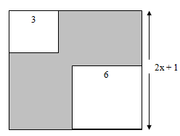in the figure above, the square LMNO has a side of length 2x+1 and the two smaller squares have sides of lengths 3 and 6. if the area of the shaded region is 76, what is the value of x?
A. 5
B. 6
C. 7
D. 11
E. 14
The OA is A.
I'm confused with this PS question, can I say that the total area is
(2x+1)^2=3^2+6^2+76
Then can I get the value of x from this equation, right? Experts, any suggestion? Thanks in advance.
Hi LUANDATO,
Let's take a look at your question.
The length of the square is (2x+1), therefore the area of the bigger square is:
$$\text{Area of Big Square}=\left(2x+1\right)^2 $$
Area of the shaded region and areas of two smaller squares add up to the area of the bigger square. Hence,
Area of Big Square = Area of Square with side 3 + Area of Square with side 6 + Area of shaded region
$$\left(2x+1\right)^2=3^2+6^2+76$$
$$\left(2x+1\right)^2=9+36+76$$
$$\left(2x+1\right)^2=121$$
Taking square root on both sides:
$$\sqrt{\left(2x+1\right)^2}=\sqrt{121}$$
$$2x+1=11$$
$$2x=11-1$$
$$2x=10$$
$$x=\frac{10}{2}$$
$$x=5$$
Therefore, Option
A is correct.
Hope it helps.
I am available if you'd like any follow up.





















